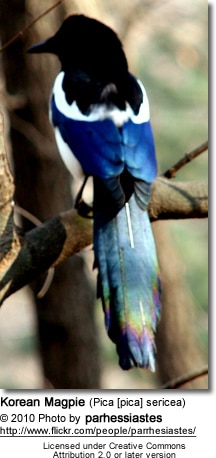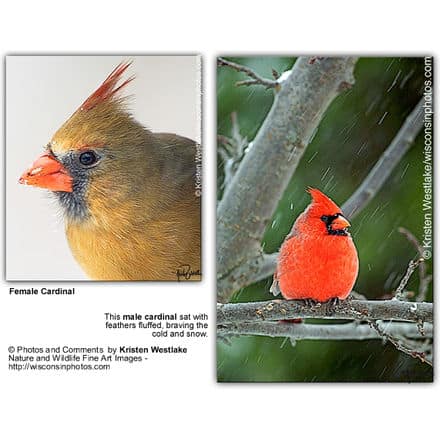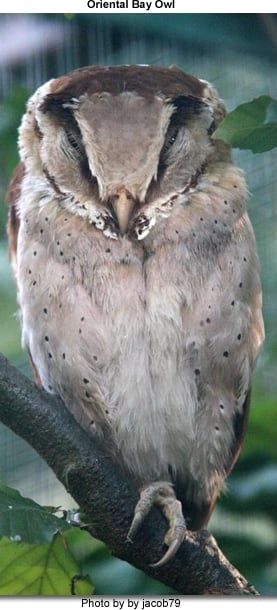Korean Magpies (birds)
The Korean Magpie (Pica [pica] sericea) is generally treated as an East Asian species, of which the European Magpie is a subspecies (Pica pica), but it may be a distinct species.
It is a common symbol of the Korean identity and has been adopted as the “official bird” of numerous South Korean cities, counties, and provinces. But it is not limited to the Korean Peninsula and if a good species it may extend almost to the Himalayas. Consequently, other vernacular names may be used for this bird, e.g. Asian Magpie or Chinese Magpie.
Description
Compared to the European Magpie, it differs not in size but is somewhat stockier, with a proportionally shorter tail and longer wings. The back, tail, and particularly the remiges (flight feathers) show strong purplish-blue iridescence with few if any green hues. The populations found east of the Tibetan Plateau, which might belong to this species, are larger (the largest Pica magpies on Earth). They have a rump plumage that is mostly black, with but a few and often hidden traces of the white band that connects the white shoulder patches in their relatives.
Calls / Vocalizations
The Korean Magpie has a similar chatter call as the European birds, but it is markedly softer.
Systematics and evolution
Recent research comparing 813 bp mtDNA sequences indicates that either all Pica magpies should be considered races of one species, or that P. p. sericea needs to be separated as a distinct species; it has been reproductively isolated for longer even than the Yellow-billed Magpie (P. nuttalli) of North America.
Hence, pending more comprehensive studies, the species binomen is put into parentheses, indicating that this bird may or may not be considered distinct. The large magpies found from the eastern Himalayas region to southern China (Tibetan Magpie or Black-rumped Magpie, P. p. bottanensis) could belong to sericea if that is split off as a species.
The relationships of P. p. leucoptera, found north of the arid lands of Mongolia, is yet to be determined, but the similar-looking subspecies from Kamchatka Krai and its surroundings (P. p. camtschatica) is the easternmost population of the “European” Magpie.
Of particularly interest is also the population called P. p. jankowskii (which is often included insericea); this taxon refers to the birds found north of Korea, towards the range of leucoptera. P. p. japonica from southern Japan is usually included in sericea today.
![Korean Magpie (Pica [pica] sericea](https://earthlife.net/wp-content/uploads/KoreanMagpie_ZdyZ-Npb0-1-1-1-1-1.jpg)
![Korean Magpie (Pica [pica] sericea)](https://earthlife.net/wp-content/uploads/KoreanMagpie2_sulZBoEUEf-1-1-1-1-1.jpg)
It seems that the Korean Magpie’s evolution as a distinct lineage started considerably earlier than the Gelasian date of c.2 million years ago (Ma) indicated by a molecular clock analysis.
The assumed divergence rate – 1.6% point mutations per Ma – is appropriate for a long-lived passerine, but hybridization – which as only mtDNA was used would be hard to detect – and the few specimens analyzed make the molecular clock estimate just an approximation.
Meanwhile, the fossil record of North American magpies has a specimen – UCMP 43386, a left tarsometatarsus from Palo Duro Falls (Randall County, Texas) – which is probably from the Early Pleistocene Irvingtonian age, around 2-1 Ma. It shows the distinct features of a Black-billed Magpie (P. (p.) hudsonia), though it might be from a common ancestor of Black- and Yellow-billed Magpies.
This was not used to calibrate the molecular clock analysis, but accounting for the phylogenetic hypothesis it appears more likely that the Korean Magpie’s ancestors diverged from other Pica in the Early Pliocene already, perhaps 5-4.5 Ma, antedating the uplift of the Sierra Nevada which cut off most gene flow between the two North American populations.
Residual gene flow between them (and between the two (or more?) Eurasian magpie lineages) until the onset of the Quaternary glaciation some 2.6-2 Ma may also have skewed the molecular clock results.
Like the other Pica magpies, the Korean Magpie is a member of the large radiation of mainly Holarctic corvids, which also includes the typical crows and ravens (Corvus) nutcrackers (Nucifraga) and Old World jays.
The long tail might be plesiomorphic for this group, as it is also found in the tropical Asian magpies (Cissa and Urocissa) as well as in most of the very basal corvids, such as the treepies. The unique black-and-white color pattern of the “monochrome” magpies is an autapomorphy.





